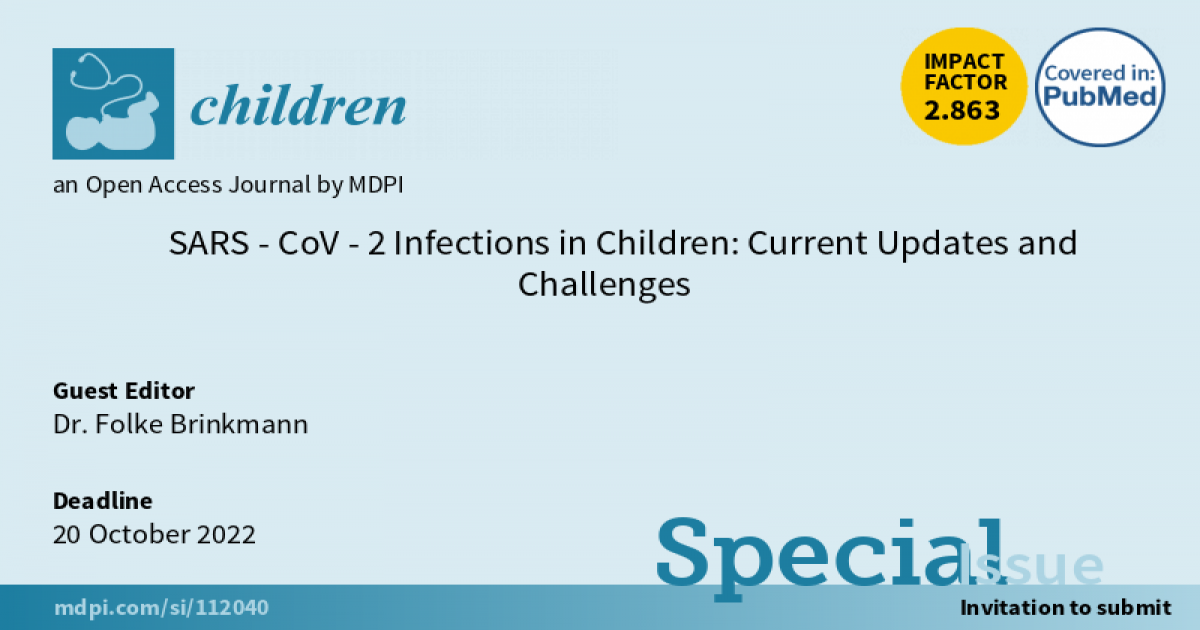SARS-CoV-2 Infections in Children: Current Updates and Challenges
A special issue of Children (ISSN 2227-9067). This special issue belongs to the section "Pediatric Infectious Diseases".
Deadline for manuscript submissions: closed (20 October 2022) | Viewed by 26425

Special Issue Editor
Interests: pulmoary infectious diseases; pediatric; tuberculosis; SARs-CoV-2; infection in chronic lung diseases (cystic fibrosis, primary ciliary dyskinesia)
Special Issue Information
Dear Colleagues,
SARS-CoV-2 infections in children are usually less severe than in adults. Nevertheless, some children, especially those with comorbidities, can experience severe cases of COVID-19. To identify children at risk and treat them in time remains a challenge. Many therapeutic options have been evaluated in adult studies, but not yet in the younger population. Vaccination can prevent acute infection as well reduce the risk of sequalae SARS-CoV-2 infection in children, including paediatric inflammatory multiorgan syndrome (PIMS) as well as Long COVID, but is still the subject of discussion amongst scientists and caregivers. These conditions have been described both in adults and children, but there is still uncertainty about the diagnosis of Long COVID in children, as well as essential diagnostics and evidence-based treatment. In addition to this, schools and day-care facilities have closed during the pandemic due to prolonged lockdowns and this has significantly reduced children and adolescents’ physical and mental well- being.
This Special Issue focuses on current findings regarding SARS-Cov-2 infection in children, innovative diagnostics and therapeutic options as well as an update on the current situation of children and adolescents during the pandemic.
Dr. Folke Brinkmann
Guest Editor
Manuscript Submission Information
Manuscripts should be submitted online at www.mdpi.com by registering and logging in to this website. Once you are registered, click here to go to the submission form. Manuscripts can be submitted until the deadline. All submissions that pass pre-check are peer-reviewed. Accepted papers will be published continuously in the journal (as soon as accepted) and will be listed together on the special issue website. Research articles, review articles as well as short communications are invited. For planned papers, a title and short abstract (about 100 words) can be sent to the Editorial Office for announcement on this website.
Submitted manuscripts should not have been published previously, nor be under consideration for publication elsewhere (except conference proceedings papers). All manuscripts are thoroughly refereed through a single-blind peer-review process. A guide for authors and other relevant information for submission of manuscripts is available on the Instructions for Authors page. Children is an international peer-reviewed open access monthly journal published by MDPI.
Please visit the Instructions for Authors page before submitting a manuscript. The Article Processing Charge (APC) for publication in this open access journal is 2400 CHF (Swiss Francs). Submitted papers should be well formatted and use good English. Authors may use MDPI's English editing service prior to publication or during author revisions.
Keywords
- SARS- CoV- 2
- pandemic
- severe infection
- COVID-19
- PIMS
- long COVID
- vaccination
- lockdown
- therapy






